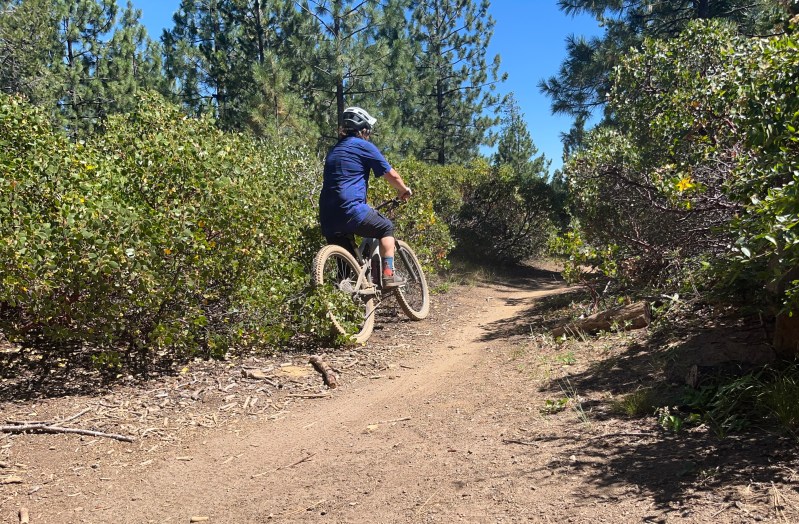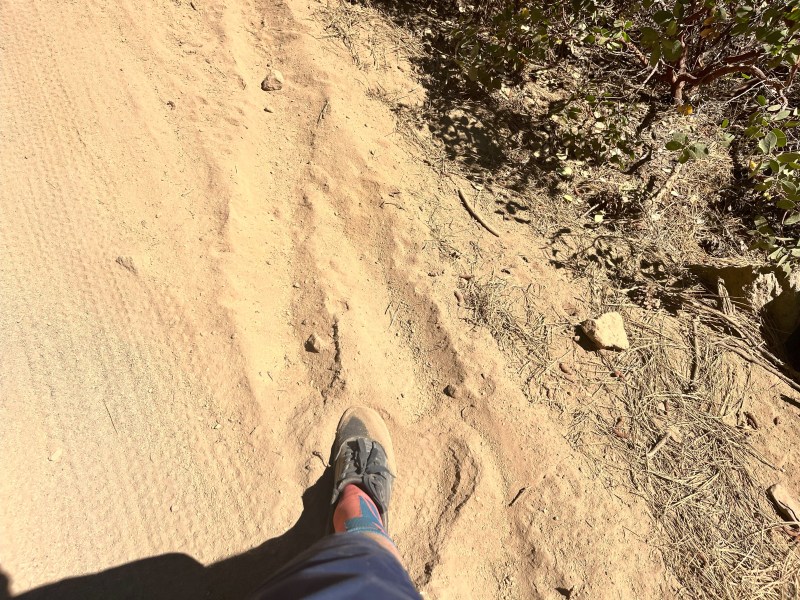
If you are new to mountain biking, you may not know that there is a set of rules that comes with riding the trails. While some may be in the camp of “rules” and “mountain bikes” never being able to coexist, the reality is that we access mostly multiuse trails where it’s helpful if everyone is on the same page.
Enter trail etiquette.
But trail etiquette is a bit more nuanced than you might think. Unlike the laws of the land at a mountain bike park, with chairlifts taking riders up and the only traffic being downhill, there is a lot more gray area concerning mountain biking trail etiquette.

Multiuse, what’s that?
A trail deemed “multiuse” means you will likely find three types of users — mountain bikers, runners/hikers, and horseback riders. Other times, you may see a trail closed to horses, but open for mountain bikes and foot traffic. This is still multiuse.
Or, you may ride on a trail system where the horseback riding trails are separate from mountain biking. However, you will find areas where these trails intersect and you are likely to encounter other users.
And while there are trails where you can find all three groups, it isn’t uncommon for different users to find their trails and stick to them. For example, horseback riders may stay on trails mostly trafficked by other equestrians, despite the trail being open to hikers and bikers.
It’s when all users mix it up together that it is important to know what to do. So let’s chat about the black and white, and the gray when it comes to encountering other users while mountain biking on multiuse trails.

Encountering another mountain biker
Heading out to well-known mountain biking trails will likely have you encountering, you guessed it, other mountain bike trail users. Knowing what to do will not only keep users safe, but it will also keep your ride flowing smoothly.
Passing other mountain bike riders usually breaks down into a couple of scenarios. We’ll break them down so we know what to do in each instance.
- Uphill vs. downhill riders. The thrill of riding as fast as you can down the hill you just climbed up is the reason many of us mountain bike. But keep in mind as you rip down the hill that there may be other riders coming up. You need to stop. Climbing is much harder than descending.
- Passing a slower rider. You may encounter mountain bikers heading in the same direction as you, but a bit slower. No big deal, give them a heads-up that you’re there and would like to pass. Something like, “Hey there, coming up behind you, I’ll pass at that wide spot ahead,” goes a long way.

Encountering hikers and runners
Those on foot are the other group you are likely to encounter. Here, it’s pretty simple. Their feet have the right of way over your wheels. Uphill or downhill, etiquette is such that mountain bikes should stop off to the side of the trail to let hikers and runners pass.
This doesn’t always happen, however, as common sense often comes into play. A hiker who encounters a mountain biker 100 feet off will often step off the trail and wave the rider through. Pedaling 100 feet is much quicker and perhaps less awkward than waiting for the hiker to hustle down the trail because the mountain bike has pulled over. Be sure to show your appreciation as you pass.
Surprising hikers and runners is usually the biggest trail conflict those mountain biking will encounter. This especially can happen when riding up behind them if they are going in the same direction as you. Here are some etiquette tips.
- Announce your presence a ways off. Nobody likes a voice all of a sudden from 8 feet behind them.
- Slow down more than you think. You may have substantially slowed, but to a hiker only going 2 miles an hour or so, you may be going rather fast.

Encountering horseback riders
The horse trumps all. This makes sense, as it is unlikely that your mountain bike will spook, throw you off, or trample the other trail user as it takes off up the hill.
With horses out of their element, encountering people mountain biking on a trail ride can be a strange experience for them. Take into account all the mountain biking gear carried, not to mention this strange contraption of the bike itself, and the horse may not realize you are a person. Knowing what to do can keep people out of potentially the most dangerous trail user encounters.
- Announce your presence to the horse rider and stop. From this point on, the rider on the horse is in charge.
- All horses are different, so the rider may ask different things of you. I’ve been asked to step far off the trail, further than I would think. I’ve also been asked to stay near the trail, so the horse can give me a sniff as it goes by. One equestrian even asked if I wouldn’t mind giving her horse a pet. “He’ll just stand there and look at you until you do,” she told me. I happily obliged.
- Really, communication is the biggest thing. Ask the rider what they want you to do and make it happen.
- In most cases, if a horse does spook, it will run uphill. Standing off the trail on the downside of a hill is usually safer.
- I’ve also always been told to talk. A big factor is that the horse knows you’re just another person. Don’t hide, and don’t be afraid to chat, even to the horse.

The nuanced, gray areas
Like everything else in life, mountain biking etiquette is not as black and white as we’d always like. Typically, the two commons — common sense and common courtesy — trump etiquette. Here are some examples.
- If I am climbing up a hill on a solo mountain bike ride and encounter a group ride about to go down the hill, I’ll pull over and let them go. Yes, this goes against etiquette, but it just makes more sense for one rider to find a spot to stop rather than five or six. Plus, those going down will pass much faster than me riding up.
- In fact, with the ascending and descending etiquette, I will often stop for any mountain biker, even if they’re by themselves, to let them keep descending. The ride down is why I ride up, so I like to keep the flow going.
- Get a bell. Some areas around the country, such as Southern California, ask mountain bikers to have a bell hanging from their handlebars. This lets hikers know you’re coming down. I’ve often come around tight corners to find a group of hikers standing off the trail, wanting me to pass. Alerting to my presence is greatly appreciated, plus, the bell may scare off wildlife if you’re in bear country.
- Know the rules of the particular trail system. Are e-bikes allowed? Is the trail a climbing or descending-only trail? Are pets allowed? Each area can have some additional rules and etiquette. A local bike shop is a great place to learn the ins and outs.
- Take care of the trails. They are there for your enjoyment, but a lot of time and manpower go into maintaining them. Poor braking and skidding do a lot to damage the trail, making inches of loose dirt that grab wheels. Go slow at first until you know the trail well.
The biggest thing is to be kind and respectful. Say “hello” and “thank you,” and make sure you have good communication in general. If somebody isn’t following proper etiquette or is rude, don’t let it ruin your day. Now that you know proper mountain biking etiquette, don’t ruin anybody else’s day.



